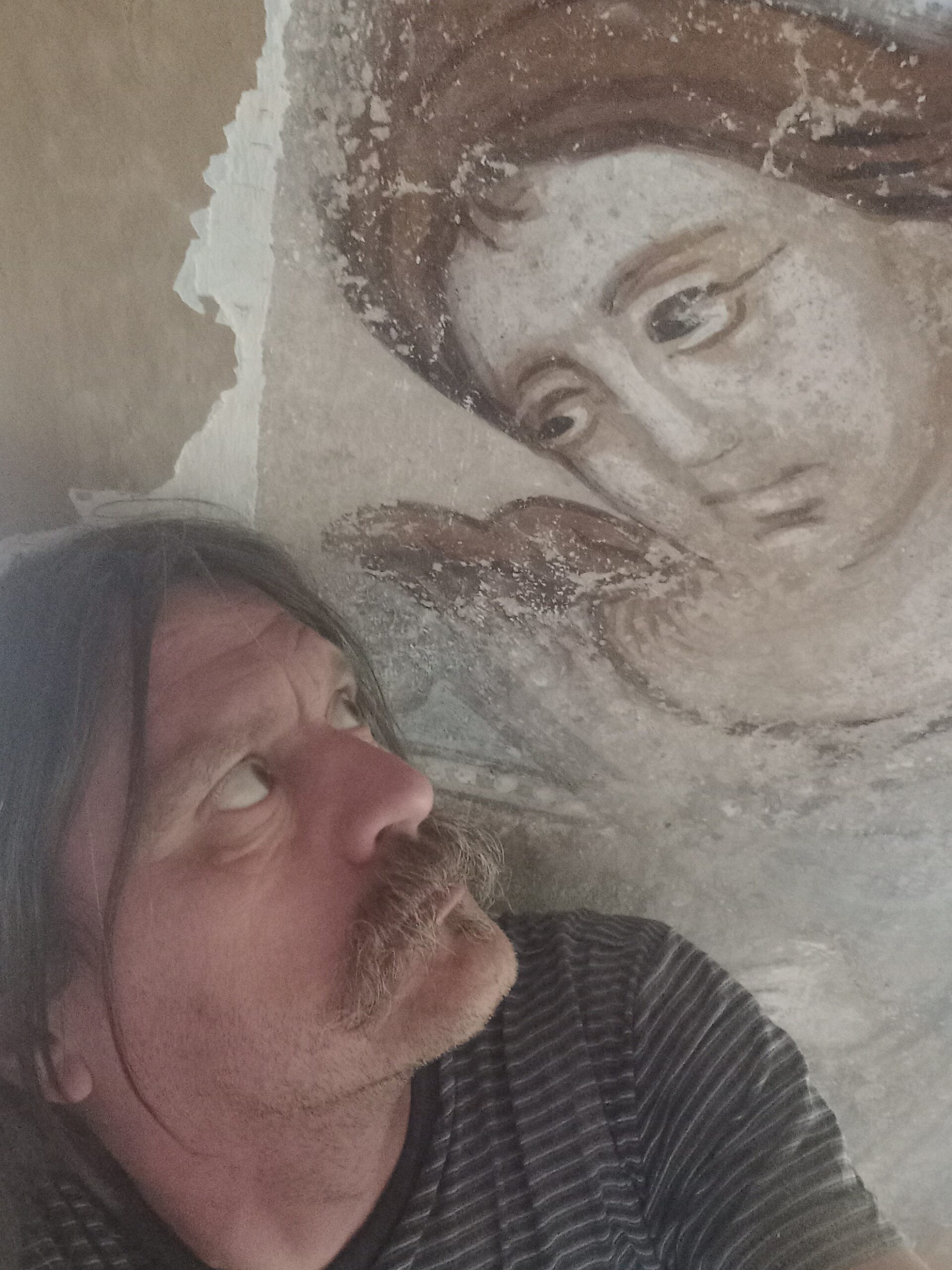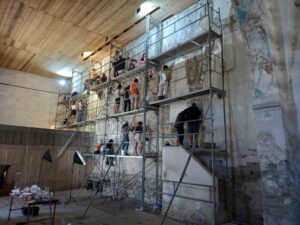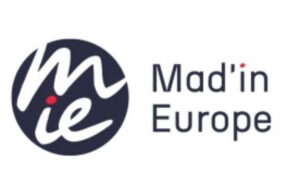This interview is part of a series of interviews with European craftspeople conducted in collaboration between FRH, the European network for religious heritage, and Mad’in Europe, the network of European fine and traditional crafts and cultural heritage restoration professions.

Lorand Kiss is a Hungarian restorer of wall paintings. He has been uncovering and restoring frescoes in churches, mostly in Transylvania, for more than 20 years. Nowadays he has a small workshop where he teaches young people how to restore historic murals using centuries-old techniques and traditional tools. Read our interview with him to learn more about his job and his views on the future of the profession.
1. Please introduce yourself (profession, area of expertise and years of experience).
My name is Lorand. I am a Hungarian born in Romania, and I am a restorer. Together with my colleagues, I have been restoring Transylvanian wall paintings and canvas paintings for 20 years.
2. What clients/markets do you work with (are they local, national or international)? Which needs does your work generally tackle? Which are the required skills and certifications that your customers request?
Our clients tend to be regional, mostly from the region of Transylvania. We work for churches, private clients and foundations that care for monuments.
Restorations in historical buildings must comply with the requirements of the Romanian state, including the Ministry of Culture. There is a special authority for artworks, wall paintings, carpets, stone works and so on. So the restoration work must be coordinated by a professional restorer authorised by the Ministry of Culture and carried out on the basis of a project approved by the corresponding authority.
We have relatively few contracts with the government because the reality is that they are not very interested in investing in the care of the monuments in this region.
3. Please briefly explain how your profession is related to religious heritage and/or cultural heritage.
Given that a significant part of our restoration work takes place in churches, our contact with the sacred spaces and within them with sacred art is commonplace. So we are closely related to cultural heritage in two ways: firstly, through the exercise of our profession, since 80% of our work takes place in churches; and secondly, in a more spiritual way, since working in this context always has a more spiritual dimension.
There are a variety of churches and buildings, but we work a lot in medieval churches. In communist times, there was a lack of care for monuments and research. In the last 20 years, we have discovered a lot of unknown medieval wall paintings and frescoes.
4. Please describe the main steps of your usual working process and the materials that you use most.
The first phase of our work is research and condition assessment, which involves mapping and assessing the state of conservation of the mural paintings to determine what restoration method is more suitable. Just like when you have a sick person and you go to the hospital the first step is to examine the patient, when you have an old historical building you need to do some research, take some samples for chemical and physical analysis and so on.
The case of Protestant churches in Romania is very particular due to the fact that after the Reformation all the saints and Catholic wall paintings were whitewashed or plastered. The second phase of the work, therefore, consists of uncovering, retouching and finally preserving the painting.
In terms of materials, the first phase involves a lot of technology to carry out the research work. In the second phase, when you come into contact with the mural painting, you have to work with traditional tools and materials. The idea then is to work with materials as close as possible to the original.

5. Do you regularly cooperate with craft professionals from other fields? If yes, can you explain which ones and why?
This is one of the most exciting aspects of this job: when all of the specialists are together in the building to uncover and put together information about it.
Research is a very multidisciplinary task and it is very important to work together with an architect, an art historian, a stone restorer, a wood restorer and other professionals. Each of them can provide a piece of information and then, just like a puzzle, you can combine the pieces of information to have a complete story of the building, the wall painting, how and when it was made, etc.
I really enjoy this part because I get to work with amazing people.
6. Please mention any innovation that helped improve your work (technological, digital, material related, legal…) and explain the impact they had on your profession.
Perhaps it is not an innovation, but I can mention a workshop we made under the theme of medieval painting. During this workshop, we made a replica of a medieval mural painting using traditional materials and techniques. It was very helpful for us to go through the whole process to understand the technology of medieval mural painting.
We use of course digital techniques for the mapping of the wall paintings and the three-dimensional scanning of the surfaces. It is in the end a combination of new technologies and traditional crafts, but the crucial part is the traditional techniques and the collaboration with other professionals.
7. How did you learn the profession? Can you detail your learning path mentioning schools and workshops where you were trained?
I studied at the University of Fine Arts in Cluj. Then I took part in a practical training at the State Restoration Center in Budapest, Hungary. But what I can say, the most important part of my studies has been collaborative work and research. Most of what I have learned has been from experienced colleagues and field work.
8. Do you pass on your knowledge to young people? If yes, how? In schools, through workshops…?
After five or six years after we set up our business, we started to work with students, offering them training in the field of restoration. After a few years of working together, the students usually set up their own companies and start working on their own restorations. We keep a sort of network, which is very good. Within this network, the mentality is not to stick to one’s own thing, but information comes and goes and everybody helps each other.
We also offer workshops and volunteer opportunities. Our centre is housed in an old fortified church. We invite teachers and students from everywhere, and we also collaborate with other organisations to host thematic workshops but we try to not work with many people at one time. We usually have a maximum of 20 people.
9. What would you recommend to a young person interested in your profession? What are the opportunities and areas in which they can work with your skills?
I will say something very subjective. From my experience, for those who work in this profession and even love it, hidden dimensions open up connections between architectural styles of art. But it is not easy, for example, because of the nomadic living conditions and everything. But if you start to introduce yourself to these historical buildings, you start to understand the hidden dimensions of these buildings, you can start to understand the painter who was working in this church and in the next church and in another church and you start to understand the connections between them.
10. Which are the threats that may endanger your profession? Can you mention some difficulties that are associated with your work? Which could be the solutions to better support your profession and preserve the transmission of skills?
In Romania, and especially in Transylvania there are many unrestored monuments in poor condition. Just last week, two medieval churches collapsed in this region. We are experiencing a lack of state responsibility.
There are a lot of foundations, organisations and private persons who spend money to keep historic buildings up. But this is just one part. The task of saving all this heritage is too great, too big. If the state doesn’t do something, there will be few changes to protect all of these buildings.
 Mad’in Europe (MIE) is a small company committed to promoting craft professionals and crafts professions and to supporting the transmission of crafts skills at a European level. Its multilingual portal gathers a large audience around the profiles of 1,500 crafts, restorers and fine crafts professionals. As a member of some European organizations and thanks to its wide European network MIE participates in several transversal activities including Erasmus and Horizon projects which focus on valorisation of crafts, preservation of traditional know-how, and raising awareness among young people, for whom the sector represents a source of employment.
Mad’in Europe (MIE) is a small company committed to promoting craft professionals and crafts professions and to supporting the transmission of crafts skills at a European level. Its multilingual portal gathers a large audience around the profiles of 1,500 crafts, restorers and fine crafts professionals. As a member of some European organizations and thanks to its wide European network MIE participates in several transversal activities including Erasmus and Horizon projects which focus on valorisation of crafts, preservation of traditional know-how, and raising awareness among young people, for whom the sector represents a source of employment.
 Future for Religious Heritage (FRH) is an independent, non-faith, non-profit European network founded in 2011 and based in Brussels to promote, encourage and support the safeguard, maintenance, conservation, restoration, accessibility and embellishment of historic places of worship. Our network represents more than 80 organisations and over 120 professionals from 36 countries, which includes NGOs, governmental organisations, religious and university departments, and individuals. We are one of the 36 European networks currently supported by the Creative Europe Networks programme.
Future for Religious Heritage (FRH) is an independent, non-faith, non-profit European network founded in 2011 and based in Brussels to promote, encourage and support the safeguard, maintenance, conservation, restoration, accessibility and embellishment of historic places of worship. Our network represents more than 80 organisations and over 120 professionals from 36 countries, which includes NGOs, governmental organisations, religious and university departments, and individuals. We are one of the 36 European networks currently supported by the Creative Europe Networks programme.





Follow us: